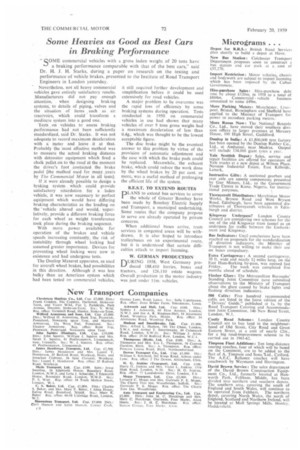Some Heavies as Good as Best Cars in Braking Performance
Page 40

If you've noticed an error in this article please click here to report it so we can fix it.
qcodE commercial vehicles with a gross laden weight of 20 tons have "-) a braking performance comparable with that of the best cars," said Dr. H. J. H. Starks, during a paper on research on the testing and
performance of vehicle brakes, presented to the Institute of Road Transport Engineers in London yesterday.
Nevertheless, not all heavy commercial vehicles gave entirely satisfactory results. Manufacturers did not pay enough attention, when designing braking systems, to details of piping, valves and the situation of items such as air reservoirs, which could transform a mediocre system into a good one.
Tests on vehicles to assess braking performance had not been sufficiently standardized, said Dr. Starks. It was not adequate to record maximum-deceleration with a Meter and leave it at that. Probably the most effective method was to measure the actual braking distance with detonator' equipment which fired a chalk pelleton to the road at the moment the driver's foot contacted the brake pedal [the method used for many , years by The Commercial Motor in all tests].
If it were already possible to design a braking system which could provide satisfactory retardation for a laden vehicle, it was now necessary to perfect equipment which would have differing braking characteristics as the loading on the 'vehicle altered and would, superlatively, provide a different braking force for each wheel as weight transference took place during the braking sequence.
With more power available for operation of the brakes and vehicle speeds increasing constantly, the risk of instability through wheel locking had assumed greater importance. Devices for preventing wheel locking were now in existence and had undergone tests.
The Dunlop Maxeret apparatus, as used for aircraft wheel brakes, had possibilities in this direction. Although it was less bulky than an American system which had been tested on commercial vehicles,
it still required further development and simplification before it could be used extensively for road vehicles.
A major problem to be overcome was the rapid loss of efficiency by some braking systems during operation. Tests conducted in 1950 on commercial vehicles in use had shown that many vehicles of over 9 tons gross weight had a maximum deceleration of less than 0.4g., which was thought to be the lowest acceptable figure.
The disc brake might be the eventual answer to this problem by virtue of the provision of automatic adjustment and the ease with which the brake pads could be replaced. Meanwhile, the exhaust brake, which could reduce the work done by the wheel brakes by 20 per cent. or more, was a useful method of prolonging the efficient life of the system.
LEST. TO EXTEND ROUTES
PLANS to extend bus services to cover the whole of Greater Bombay have been made by Bombay Electric Supply and Transport, a municipal undertaking. Some routes that the company propose to serve are already operated by private concerns.
When additional buses arrive, tram services in congested areas will be withdrawn. It is also hoped to introduce trolleybuses on an experimental route, but it is understood that certain difficulties attach to import licensing.
W. GERMAN PRODUCTION nURING 1958, West Germany pro
duced 188,410 lorries, buses and tractors, and 126.110 estate wagons. Overall production in the motor industry was just under I-fm. vehicles.








































































































